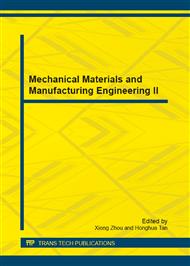[1]
M. Field, J. F. Kahles, The surface integrity of machined and ground high strength steels. DMIC Report 210 (1964) 54–77.
Google Scholar
[2]
M. Field, J. F. Kahles, Review of surface integrity of machined components. Annals of the CIRP 20(2) (1971) 153–162.
Google Scholar
[3]
L. Palaghian, Siguranţă, durabilitate şi fiabilitate la oboseală, Editura Tehnică, Bucureşti (2007).
Google Scholar
[4]
V. Mereuţă, C. Gheorghieş, L. Palaghian, Roughness as small surface defects and microstructure changes in fatigue process, The Annals of Dunărea De Jos, University of Galaţi, Fascicle VIII, Tribology, (XVII), Issue 1, (2011).
Google Scholar
[5]
V. Mereuţă, L. Palaghian, Surface Roughness Parameters Evolution Under Fatigue Loading, The Annals of University Dunărea de Jos, of Galaţi Fascicle VIII, (XVI), Issue 1, (2010).
Google Scholar
[6]
Yue Z. F., Surface roughness evolution under constant amplitude fatigue loading using crystal plasticity, Engineering Fracture Mechanics, Volume 72, Issue 5, 2005 749–757.
DOI: 10.1016/j.engfracmech.2004.06.001
Google Scholar
[7]
D. Taylor, O.M. Clancy, Fatigue performance of machined surfaces, Fatigue and Fracture of Engineering Materials and Structures 14 (2-3) (1991) 329–336.
DOI: 10.1111/j.1460-2695.1991.tb00662.x
Google Scholar
[8]
G. Deng, K. Nagamoto, Y. Nakano, and T. Nakanishi, Evaluation of the effect of surface roughness on crack initiation life, ICF12, Natural Resources Canada, Ottawa, Canada, (2009) 1-8.
Google Scholar
[9]
E. Siebel, M. Gaier, The influence of surface roughness on the fatigue strength of steels and non-ferrous alloys, The Engineers' Digest, Vol. 18, No. 3 (1957) 109-112.
Google Scholar
[10]
P. Maiya, D. Busch, Effect of surface roughness on low cycle fatigue behavior of type 304 stainless steel, Metallurgical Transactions A, Vol. 6A 1975 1761-1766.
DOI: 10.1007/bf02642305
Google Scholar
[11]
D. Arola, C.L. Williams, Estimating the fatigue stress concentration factor of machined surfaces, International Journal of Fatigue 24 (2002) 923–930.
DOI: 10.1016/s0142-1123(02)00012-9
Google Scholar
[12]
D. Arola, A. E. Alade, W. Weber, Improving Fatigue Strength of Metals Using Abrasive Waterjet Peening, Machining Science and Technology, 10 (2006) 197–218.
DOI: 10.1080/10910340600710105
Google Scholar
[13]
H. P. Neuber, Kerbspannungslehre, 2nd ed., Springer, New York, (1958).
Google Scholar
[14]
H. Itoga, K. Tokaji, M. Nakajima, H. -N. Ko, Effect of surface roughness on step-wise S–N characteristics in high strength steel, International Journal of Fatigue, Volume 25 Issue 5 2003 379-385.
DOI: 10.1016/s0142-1123(02)00166-4
Google Scholar


